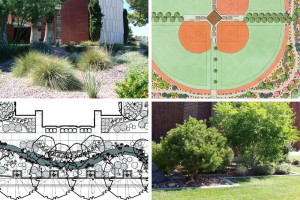The Greatest Guide To Landscape Design
Table of ContentsThe Ultimate Guide To Landscape DesignOur Landscape Design PDFsThe smart Trick of Landscape Design That Nobody is DiscussingThe Basic Principles Of Landscape Design Not known Incorrect Statements About Landscape Design
Official style motif. Credit: Gail Hansen, UF/IFAS The yard is an expansion of the home where a selection of tasks take place. A backyard can usually be separated right into three areas: public (the front lawn), exclusive (the backyard), and service (normally the side yard). The location of task locations depends mainly on the sort of location, the dimension of space required, the kind of activity, and the wanted distance to other tasks and structures.The outdoors wall of your house commonly functions as the initial wall or beginning point of an exterior room. Inappropriate uses must be separated, and associated tasks, such as cooking and eating, should be created to make the lawn extra effective and enjoyable. When using hardscape to produce spaces, utilize building and construction product similar to that utilized in the house for connection from your home into the yard.
Linked areas. Debt: Gail Hansen, UF/IFAS Utilizing comparable hardscape attributes and repeating plants pulls the eye around the garden. Vital points in the process can be highlighted with growings or attributes that draw interest and motivate activity in a certain direction. Moving along the path takes a person from one area to the next and enables the customer to have a selection of experiences.
The Main Principles Of Landscape Design

For mental convenience plants are made use of as physical or suggested obstacles for privacy and safety and security. Physical obstacles block both the sight and access to a space and consist of fences, wall surfaces and plant hedges.
Physical and implied obstacles. Credit Scores: Gail Hansen, UF/IFAS For these reasons, the kinds of plants to be used (such as trees, hedges, or groundcovers) must be chosen in the very early phases of planning (Landscape Design). Plant kinds are selected for their useful abilities so that their future function and required area can be considered at the exact same time

The Best Strategy To Use For Landscape Design
Each plant mass is in front of, behind, or next to, one more mass. Number 11. Horizontal plant layers. Credit: Gail Hansen, UF/IFAS Number 12. Vertical plant layers. Landscape Design. Credit Rating: Gail Hansen, UF/IFAS Duplicating plants within a mass and duplicating masses with similar plants connects the garden together. The individual plant attributes must be considered to efficiently layer and mass plants.
All plant compositions begin with the main structure plants, the big, mostly evergreen background plants-such as the their explanation trees and large shrubs. These plants separate or enframe spaces, control the size of the space, and provide the starting point for choosing the appropriate qualities of the second layer, midground plants, for massing and infill.
Crucial factors in the yard must be highlighted by the use one-of-a-kind plants, distinct frameworks, or yard accessories. Noting limits or entries to spaces can be finished with entrances, arbors, and steps, or through making use of unique and colorful plants. The form and/or web design motif of the yard will commonly assist establish the crucial factors and how they should be highlighted.
Various other vital areas in the lawn are centerpieces, which is used to aesthetically organize a landscaped location. The kind of prime focus commonly depends on the checking out point of view. Various viewpoints or viewpoints can reveal various structures in the landscape that may call for a range of prime focus. Contrasting appearance, shape, dimension and color will catch and hold the eye.
7 Simple Techniques For Landscape Design

Plant kinds. Credit Score: Gail Hansen, UF/IFAS After type, texture is the next dominant attribute of a plant; crude, medium and fine appearances can be utilized for contrast and focus in the landscape.
The pleasurable scent of plants, the audio of wind in the trees, the noise and texture of water, and the shades and structures of sculptures, pots and garden furnishings all contribute to the experience of the garden. One information that is typically neglected is the result of light on the aesthetics of the plants.

The smart Trick of Landscape Design That Nobody is Discussing
It is necessary to recognize the eventual mature dimension of plants so they can be positioned in the right location and spaced appropriately when they are installed. Providing plants area to expand is a challenge since the usual fully grown size is typically based on ideal expanding problems and the environmental conditions of a site might create a plant to expand larger or stay smaller.
Comments on “Some Known Questions About Landscape Design.”